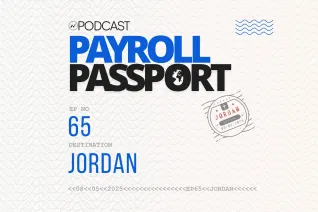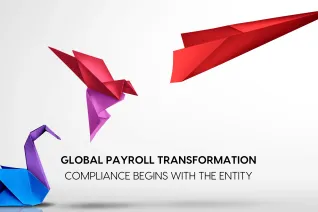How to Successfully Transition to a Global Payroll System

In today’s interconnected world, managing a global workforce has become increasingly complex. Payroll is no longer just about calculating wages and deductions; it’s about compliance, currency conversion, tax regulations, and local employment laws—all at a global scale.
A recent EY survey said that for “Organizations to reduce risk, increase compliance and build a leading operational model, creating and documenting an organization-wide formal payroll strategy is essential.” That survey showed that 67% of organizations have a formalized payroll strategy in place as of 2021, up from 61% in 2019.
Transitioning to a global payroll system can be a game-changer for organizations aiming to streamline processes, reduce costs, and maintain compliance worldwide. However, moving from a localized or fragmented payroll setup to a unified global solution requires careful planning and execution.
This blog outlines the five essential steps for a seamless transition to a global payroll system. By following these steps, organizations can establish a robust, scalable payroll structure that supports international expansion while ensuring compliance and enhancing employee satisfaction.
1. Evaluate Your Current Payroll Setup and Identify Gaps
Before embarking on the transition to a global payroll system, it’s essential to assess your existing payroll structure. This assessment will provide insights into the strengths and weaknesses of your current processes and help pinpoint areas that need improvement.
Consider these key elements during your evaluation:
- Compliance and Accuracy: Review compliance across all regions, focusing on whether payroll practices align with local tax laws and regulations. Non-compliance can lead to fines and damage your company’s reputation.
- Technology and Integration: Assess the software and technology currently in place. If your payroll is handled on disparate platforms or lacks integration with core HR or finance systems, inefficiencies and errors may be more likely.
- Employee Experience: Gauge employee satisfaction with payroll services. Are they receiving timely, accurate payments? Is the system user-friendly? Employee experience can impact productivity and retention.
- Cost Efficiency: Evaluate the costs associated with maintaining different payroll systems. Consider whether consolidating these into a global payroll solution would be more economical in the long term.
Document your findings and categorize them based on priority. This information will serve as the foundation for defining your global payroll strategy and identifying the right provider to bridge the gaps.
Know More: Payroll Companies Leveraging Software for Better Compliance Management
2. Define Your Global Payroll Strategy
A well-defined global payroll strategy provides a clear roadmap for implementation, guiding decision-making and minimizing disruptions. This step is crucial for aligning the payroll transition with broader business goals, such as scalability, compliance, and cost-effectiveness.
Key components of a successful payroll strategy include:
- Scope and Coverage: Define which countries and regions the payroll system will serve. Ensure the system supports multilingual interfaces, multicurrency capabilities, and varied tax structures.
- Compliance Framework: Establish a compliance framework to address global and local regulations, including GDPR, SOC2, and specific employment laws in each country.
- Data Standardization and Security: Standardize data formats across regions to ensure consistency and ease of reporting. Prioritize data security, especially in countries with strict data protection laws.
- Reporting and Analytics: Set up a reporting framework to track key metrics, such as payroll accuracy, processing time, and compliance status. Analytics will be valuable for continuous improvement and identifying trends across the organization.
By clearly defining these elements, you can create a payroll strategy that meets both global objectives and local requirements.
Also Read: Transforming Workforce Management with Payroll Analytics
3. Select the Right Payroll Provider
Choosing a global payroll provider is one of the most critical steps in your transition. The right provider will act as a strategic partner, not just a vendor, supporting your goals and helping you navigate complex compliance and operational challenges.
When selecting a provider, focus on the following criteria:
- Scalability and Flexibility: Ensure the provider can scale with your organization’s growth and adapt to new markets and workforce changes.
- Technology and Integration: Look for providers offering advanced technology, such as cloud-based platforms, artificial intelligence (AI), and automation. Integration with HR, ERP, and finance systems is essential to maintain a seamless data flow.
- Compliance Expertise: Select a provider with in-depth knowledge of compliance regulations across all your regions. Their support in this area will reduce the risk of penalties and ensure payroll operations are audit-ready.
- Customer Support and Responsiveness: Evaluate the provider’s customer support structure. Round-the-clock, multilingual support is particularly beneficial for a global workforce.
- Cost Structure: Compare the provider’s cost model to assess whether it aligns with your budget and long-term goals. Remember to consider hidden costs related to customization or integration.
A reliable payroll partner, such as Neeyamo, should not only handle the operational aspects of payroll but also support your strategic objectives.
4. Implement the New Payroll System
With a defined strategy and a suitable provider, it’s time to implement the new global payroll system. A well-executed implementation plan will minimize disruptions and ensure that the system functions effectively from day one.
Key considerations for a successful implementation:
- Project Planning and Phased Rollout: Design a project plan with clear timelines, responsibilities, and milestones. Implement the system in phases, starting with a few countries or business units, to address any issues before a full-scale rollout.
- Data Migration: Data migration is often a complex task, as it involves transferring sensitive payroll data securely. Verify the accuracy of migrated data through rigorous testing and validation.
- System Testing and Quality Assurance: Conduct multiple rounds of testing—unit, integration, and user acceptance testing—to identify and resolve potential issues. Testing ensures the system is ready for real-world use and provides a seamless experience for end-users.
- Communication and Change Management: Communicate clearly with employees about the transition, providing updates on changes they can expect in the payroll process. Encourage feedback and address concerns to make the transition smoother.
Implementing a global payroll system is a significant undertaking, but with the right plan, it can be done smoothly, setting the stage for long-term success.
Know how: A Guide to Implementing Workday Global Payroll
5. Train Your Teams and Continuously Optimize Processes
Even the most sophisticated payroll system requires knowledgeable teams and ongoing refinement to remain effective. Training ensures that your HR and payroll teams can leverage the system’s full capabilities, while continuous optimization keeps the system efficient and up-to-date with changing requirements.
-
Training: Organize comprehensive training sessions that cover system navigation, data entry, compliance checks, and troubleshooting. Encourage your teams to become proficient in using the system’s analytics and reporting tools, as these can provide valuable insights into payroll performance.
-
Continuous Optimization: Global payroll is dynamic, with regulatory updates, currency fluctuations, and workforce changes. Regularly review processes and system configurations to keep pace with these changes. Utilize analytics to monitor system performance and identify areas for improvement, such as processing time or compliance rates.
Consider conducting periodic audits to ensure payroll accuracy and regulatory compliance. With a cycle of continuous improvement, you can maintain an efficient and compliant global payroll system that supports your organization’s growth.
Global Payroll: A strategic Imperative
Transitioning to a global payroll system is a strategic imperative for organizations operating in an increasingly interconnected world. A well-implemented global payroll solution does more than just process wages—it provides a comprehensive approach to managing workforce complexities across different regulatory environments, currencies, and cultural contexts.
As businesses expand globally, the payroll function evolves from a back-office administrative task to a strategic business enabler. The right approach can transform payroll from a cost center to a value-added service that supports overall business objectives.
Why choose Neeyamo for your Global payroll needs?
Unlock the power of seamless global payroll management with Neeyamo's expert global payroll services. Neeyamo helps you navigate complex payroll regulations in 160+ countries, ensuring compliance and minimizing risks. Not convinced yet? Here's why we're your ideal partner:
Regulatory Roadblocks? Confidently navigate complex international laws & regulations.
Irritated with Integration? Seamlessly stitch together your HR systems.
Chaotic Control? Command your global workforce from a single platform.
Tardy Transactions? Ensure prompt and precise payroll processing.
Doubtful Digital Defense? Shield your sensitive information from digital threats.
Neeyamo? Your passport to hassle-free global payroll!
Partner with Neeyamo today to make your payroll system smarter, faster, and fully compliant—driving your business forward in a rapidly changing world.
Latest Resources
Stay informed with latest updates
If you're curious and have a thirst for knowledge pertaining to the HR, payroll, and EOR universe, don't miss out on subscribing to our resources.















